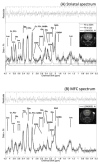Striatal magnetic resonance spectroscopy abnormalities in young adult SAPAP3 knockout mice
- PMID: 26858992
- PMCID: PMC4742338
- DOI: 10.1016/j.bpsc.2015.10.001
Striatal magnetic resonance spectroscopy abnormalities in young adult SAPAP3 knockout mice
Abstract
Background: Obsessive compulsive disorder (OCD) is a debilitating condition with lifetime prevalence of 1-3%. OCD typically arises in youth but delays in diagnosis impede optimal treatment and developmental studies of the disorder. Research using genetically modified rodents may provide models of etiology that enable earlier detection and intervention. The SAPAP3 knockout (KO) transgenic mouse was developed as an animal model of OCD and related disorders (OCRD). KO mice exhibit compulsive self-grooming behavior analogous to behaviors found in people with OCRD. Striatal hyperactivity has been reported in these mice and in humans with OCD.
Methods: Striatal and medial frontal cortex 9.4 Tesla proton spectra were acquired from young adult SAPAP3 KO and wild-type control mice to determine whether KO mice have metabolic and neurochemical abnormalities.
Results: Young adult KO mice had lower striatal lactate (P=0.006) and glutathione (P=0.039) levels. Among all mice, striatal lactate and glutathione levels were associated (R=0.73, P=0.007). We found no group differences in medial frontal cortex metabolites. At the age range studied, only 1 of 8 KO mice had skin lesions indicative of severe compulsive grooming.
Conclusion: Young adult SAPAP3 KO mice have striatal but not medial frontal cortex MRS abnormalities that may reflect striatal hypermetabolism accompanied by oxidative stress. These abnormalities typically preceded the onset of severe compulsive grooming. Our findings are consistent with striatal hypermetabolism in OCD. Together, these results suggest that striatal MRS measures of lactate or glutathione might be useful biomarkers for early detection of risk for developing compulsive behavior disorders.
Keywords: Magnetic resonance spectroscopy; Obsessive compulsive disorder; Oxidative stress; SAPAP3 protein; Striatal dysfunction; Translational model.
Figures



Similar articles
-
Increased Metabotropic Glutamate Receptor 5 Signaling Underlies Obsessive-Compulsive Disorder-like Behavioral and Striatal Circuit Abnormalities in Mice.Biol Psychiatry. 2016 Oct 1;80(7):522-33. doi: 10.1016/j.biopsych.2016.04.023. Epub 2016 May 13. Biol Psychiatry. 2016. PMID: 27436084 Free PMC article.
-
Strengthened Inputs from Secondary Motor Cortex to Striatum in a Mouse Model of Compulsive Behavior.J Neurosci. 2019 Apr 10;39(15):2965-2975. doi: 10.1523/JNEUROSCI.1728-18.2018. Epub 2019 Feb 8. J Neurosci. 2019. PMID: 30737313 Free PMC article.
-
Circuit-selective striatal synaptic dysfunction in the Sapap3 knockout mouse model of obsessive-compulsive disorder.Biol Psychiatry. 2014 Apr 15;75(8):623-30. doi: 10.1016/j.biopsych.2013.01.008. Epub 2013 Feb 13. Biol Psychiatry. 2014. PMID: 23414593 Free PMC article.
-
Molecular and cellular basis of obsessive-compulsive disorder-like behaviors: emerging view from mouse models.Curr Opin Neurol. 2011 Apr;24(2):114-8. doi: 10.1097/WCO.0b013e32834451fb. Curr Opin Neurol. 2011. PMID: 21386675 Review.
-
Fronto-striatal glutamatergic compounds in compulsive and impulsive syndromes: a review of magnetic resonance spectroscopy studies.Neurosci Biobehav Rev. 2015 May;52:74-88. doi: 10.1016/j.neubiorev.2015.02.009. Epub 2015 Feb 21. Neurosci Biobehav Rev. 2015. PMID: 25712432 Review.
Cited by
-
Converging evidence points towards a role of insulin signaling in regulating compulsive behavior.Transl Psychiatry. 2019 Sep 12;9(1):225. doi: 10.1038/s41398-019-0559-6. Transl Psychiatry. 2019. PMID: 31515486 Free PMC article.
-
LOWER POSTERIOR CINGULATE CORTEX GLUTATHIONE LEVELS IN OBSESSIVE-COMPULSIVE DISORDER.Biol Psychiatry Cogn Neurosci Neuroimaging. 2016 Feb 1;1(2):116-124. doi: 10.1016/j.bpsc.2015.12.003. Biol Psychiatry Cogn Neurosci Neuroimaging. 2016. PMID: 26949749 Free PMC article.
-
Advancing Obsessive-Compulsive Disorder Research: Insights from Transgenic Animal Models and Innovative Therapies.Brain Sci. 2025 Jan 4;15(1):43. doi: 10.3390/brainsci15010043. Brain Sci. 2025. PMID: 39851412 Free PMC article. Review.
-
Effects of cannabinoid exposure on short-term memory and medial orbitofrontal cortex function and chemistry in adolescent female rhesus macaques.Front Neurosci. 2022 Sep 30;16:998351. doi: 10.3389/fnins.2022.998351. eCollection 2022. Front Neurosci. 2022. PMID: 36248648 Free PMC article.
-
SAPAP Scaffold Proteins: From Synaptic Function to Neuropsychiatric Disorders.Cells. 2022 Nov 28;11(23):3815. doi: 10.3390/cells11233815. Cells. 2022. PMID: 36497075 Free PMC article. Review.
References
-
- Stengler K, Olbrich S, Heider D, Dietrich S, Riedel-Heller S, Jahn I. Mental health treatment seeking among patients with OCD: impact of age of onset. Soc Psychiatry Psychiatr Epidemiol. 2013;48:813–819. - PubMed
-
- American Psychiatric Association. Diagnostic and Statistical Manual of Mental Disorders: DSM-5. Washington, D.C: American Psychiatric Press; 2013.
-
- Güldenpfennig M, de Wolmarans W, du Preez JL, Stein DJ, Harvey BH. Cortico-striatal oxidative status, dopamine turnover and relation with stereotypy in the deer mouse. Physiol Behav. 2011;103:404–11. - PubMed
Grants and funding
LinkOut - more resources
Full Text Sources
Other Literature Sources
Research Materials
